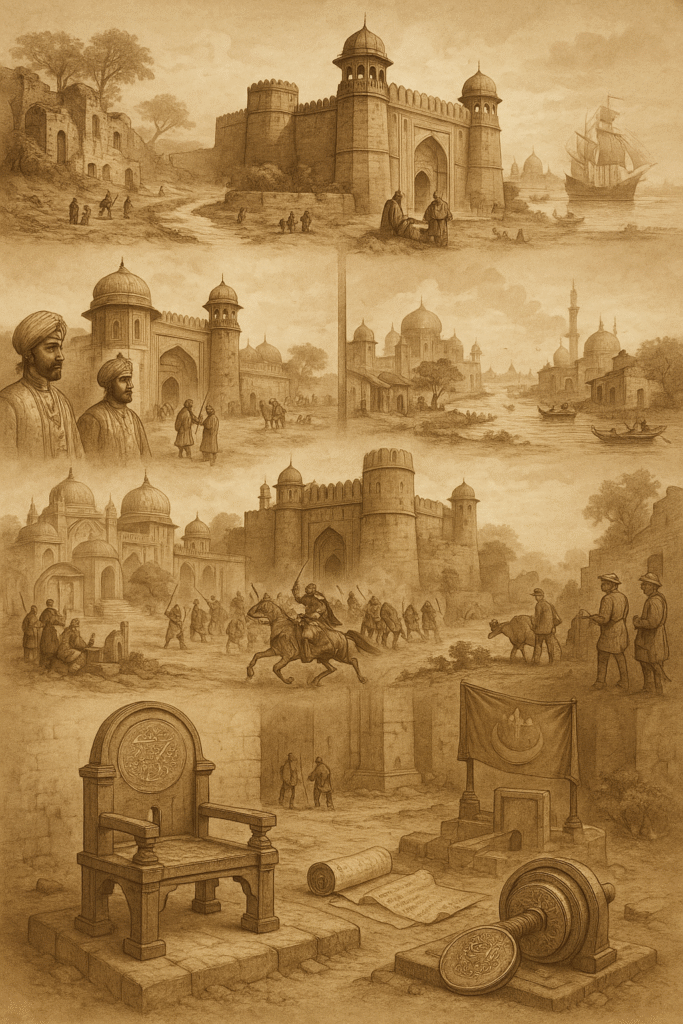
Rajmahal, located in present-day Jharkhand near the banks of the Ganga River, holds a critical place in the history of medieval Bengal under the Mughals. Once a flourishing capital and military stronghold, Rajmahal’s story is one of rise, strategic importance, and eventual decline. Below is a detailed breakdown of its historical evolution:
1. Early History and Strategic Positioning
- Gaur, the earlier capital of Bengal (1202–1576), declined due to:
- Shifting course of the Ganga River (moved westward)
- Plague outbreak in 1575 that decimated the population
- Increasingly unsanitary and uninhabitable conditions
- Rajmahal was chosen as the new capital by Man Singh, Akbar’s representative in Bengal
- Fortifications and palaces were built to emphasize defensive and administrative importance
2. Establishment as Akbar Nagar
- Rajmahal was officially established as capital in 1592
- Originally called Agamahal, then Rajmahal, and later Akbar Nagar
- Its strategic location on the Ganga provided:
- Natural protection
- Access to inland trade routes
- Man Singh ensured:
- Strong defensive walls and watchtowers
- Efficient city planning to support Mughal governance
3. Shift from Rajmahal to Dhaka
- Capital shifted to Dhaka in 1612 due to:
- Dhaka’s strategic advantage against Arakanese and Portuguese pirates
- Better maritime trade access in Dhaka
- Continual shifting of the Ganga, reducing Rajmahal’s commercial importance
- French traveler Tavernier (1666) recorded Rajmahal’s visible decline
4. Military Engagements and Political Struggles
- Rajmahal witnessed major Mughal military activity, especially:
- Shah Jahan’s rebellion (1622) against Emperor Jahangir
- Fierce conflict between Shah Jahan’s forces and those of Ibrahim Khan
- Became a key military outpost during Mughal succession wars
5. Shah Jahan’s Contributions to Rajmahal
- Shah Jahan invested in infrastructure development:
- Commissioned a new palace and defensive works
- Rajmahal briefly regained political significance under his rule
- Became the administrative base for his son Shuja, Governor of Bengal
6. Rajmahal During the Succession Struggles
- Prince Shuja governed Bengal from Rajmahal during Mughal succession conflicts
- Built grand palaces and administrative complexes
- Was defeated by Aurangzeb during the Mughal throne struggle in 1658
- Mīr Jumla captured Rajmahal, marking the beginning of its irreversible decline
7. Decline of Rajmahal
- The city’s decline accelerated under Aurangzeb’s centralized policies
- Further shift in the Ganga River’s course
- Rise of Dhaka as a capital made Rajmahal redundant
- Fortifications dismantled, and city infrastructure collapsed
- By the late 17th century, Rajmahal had lost all administrative and military relevance
8. Rajmahal’s Role in the 18th Century
- Continued to have symbolic and residual administrative importance
- Functioned as a coin-minting center under Mughals
- Still a point for tax collection and record-keeping
- Under British colonial rule, its importance declined further
9. The Legacy of Rajmahal
- Rajmahal represents a brief but significant chapter in Bengal’s Mughal-era history
- Its lasting legacy includes:
- Being a former Mughal capital
- Serving as a military outpost during critical succession struggles
- Though now a historical relic, Rajmahal’s contributions to Mughal administration and defense strategy remain crucial to understanding the political geography of early modern Bengal
Key Highlights:
- Rajmahal served as Bengal’s Mughal capital from 1592 to 1612
- Strategic river location made it vital for defense and trade
- Played a central role in Mughal political and military history
- Declined due to geographic shifts and political realignments
- Still holds symbolic value in the historical narrative of Bengal

One thought on “The Historical Legacy of Rajmahal: From Mughal Capital to Forgotten Relic”